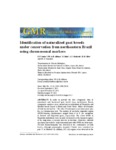Use este identificador para citar ou linkar para este item:
http://www.alice.cnptia.embrapa.br/alice/handle/doc/969537| Título: | Identification of naturalized goat breeds under conservation from northeastern Brazil using chromosomal markers. |
| Autoria: | SANTOS, R. P.  AFFONSO, P. R. A. M.   DINIZ, D.   MEDRADO, A. S.   SILVA, K. de M.   CARNEIRO, P. L. S.   |
| Afiliação: | Departamento de Ciências Biológicas, Universidade Estadual do Sudoeste da Bahia, Jequié, BA, Brasil.; Departamento de Ciências Biológicas, Universidade Estadual do Sudoeste da Bahia, Jequié, BA, Brasil; Departamento de Ciências Biológicas, Universidade Estadual do Sudoeste da Bahia, Jequié, BA, Brasil; Universidade Estadual de Santa Cruz, Campus Soane Nazaré de Andrade - Ilhéus, BA, Brasil; KLEIBE DE MORAES SILVA, CNPC; Departamento de Ciências Biológicas, Universidade Estadual do Sudoeste da Bahia, Jequié, BA, Brasil. |
| Ano de publicação: | 2013 |
| Referência: | Genetics and Molecular Research, v. 12, n. 3, p. 3193-3200, 2013. |
| Conteúdo: | Abstract: In order to provide the first cytogenetic data of naturalized and threatened goat breeds from northeastern Brazil, cytogenetic analyses were carried out in individuals of Repartida and Moxotó breeds raised in Bahia and Ceará States. Males and females of both breeds had 2n = 60, with 29 autosomal acrocentric pairs plus the sex chromosome pair. The number of nucleolar organizer region (NOR)-bearing chromosomes ranged from 6 to 8 per metaphase in Moxotó and Repartida goats, respectively. The active NORs in Repartida individuals were located exclusively at the terminal regions of the long arms, as usually detected in Bovidae. Otherwise, Moxotó specimens presented a large autosomal pair with NORs on short arms. GC-rich heterochromatin was detected at the centromeres in both breeds, although polymorphic terminal C-bands were visualized on pair 25 in Moxotó. In addition, GC-rich regions were detected at the terminal regions of the long arms of a single pair in Repartida and of 20 chromosomes in Moxotó goats. The differences in both the number and/or position of Ag-NORs and GC-rich sites between Repartida and Moxotó breeds represent efficient cytogenetic markers that can be used in the identification and conservation of the genetic integrity of each lineage. In spite of the small effective population size of these breeds, chromosomal abnormalities related to drift or inbreeding effects were absent in the samples analyzed. |
| Thesagro: | Caprino Melhoramento genético animal Citogenética animal Genética animal Cariótipo Cromossoma Conservação |
| NAL Thesaurus: | Goats Animal genetics Genetic improvement Chromosome banding Brazil |
| Palavras-chave: | Bandeamento cromossômico Raça naturalizada Brasil Região Nordeste Karyotypes Raça Moxotó |
| Digital Object Identifier: | 10.4238/2013.August.29 |
| Tipo do material: | Artigo de periódico |
| Acesso: | openAccess |
| Aparece nas coleções: | Artigo em periódico indexado (CNPC)  |
Arquivos associados a este item:
| Arquivo | Descrição | Tamanho | Formato | |
|---|---|---|---|---|
| APIIdentificationofnaturalized.pdf | 772,99 kB | Adobe PDF |  Visualizar/Abrir |









